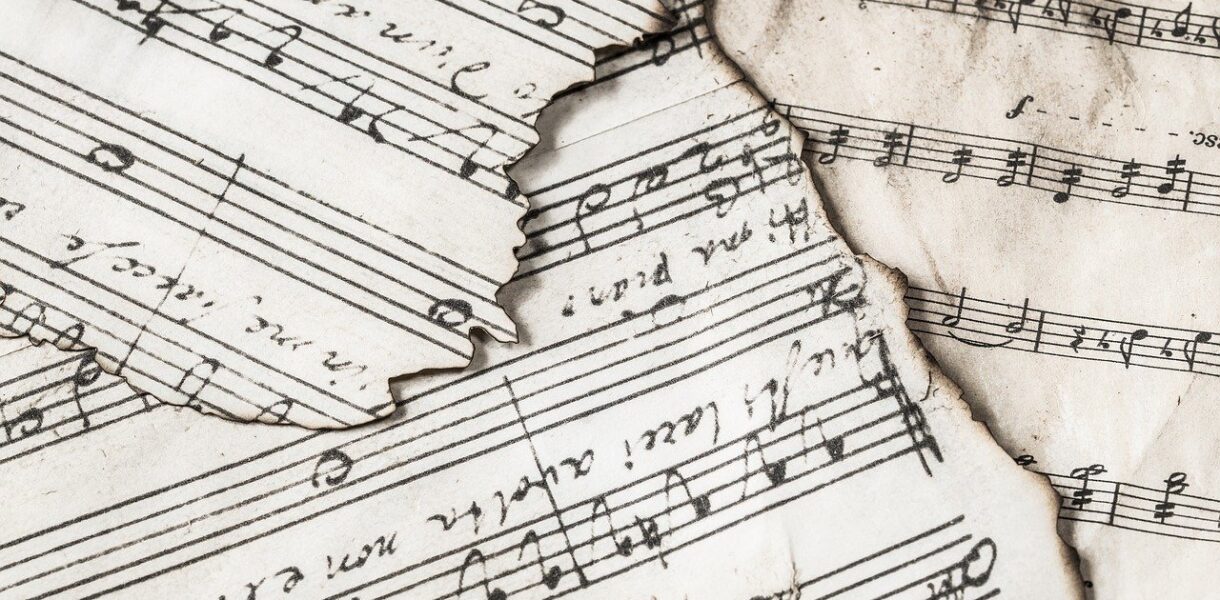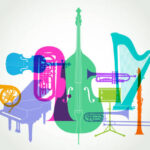Bedrich Smetana was born in Bohemia, his father an amateur violinist, and showed musical precocity from a very young age. While he was a talented pianist, it is for his compositions that Smetana became most known for. He is credited with being a hugely influential Czech composer, along with the likes of Dvořák, Janáček, and Martinů. Czech nationalism and influence are heard throughout many of Smetana’s compositions. David Oistrakh, Lev Oborin, and Sviatoslav Knushevitsky performed as a piano trio from 1940 – 1963, and are usually now unofficially referred to as “The Oistrakh Trio.” This recording was made in Moscow in 1950.
Smetana’s piano trio is one of his works that is considered to be autobiographical, along with his “From my Life” string quartet in E minor. Throughout his life, Smetana was no stranger to grief: as many as 10 of his siblings and half-siblings died in childhood, and later 3 of 4 of his own children, followed shortly after by his wife Katerina. But it was the death of his daughter Bedriska who had shown immense musical promise that prompted the composition of his piano trio in G Minor in 1855. He described her as an “angel” and an “extraordinarily gifted child,” and her premature death sent him into a period of anguished devastation and mourning.
I listen to a lot of music, but I have a special place in my heart for chamber music and this trio in particular. The G Minor trio is a massive work to grasp: it goes through so many different emotions, and you can hear the emotional baggage Smetana was carrying at this time in his life. But despite the misery that was the inspiration for the composition, this music makes me nostalgic for something I’ve never experienced. One of my favorite things about this piece is how these sweet singing sections appear out of nowhere, and it shows the multi-layered genius of the music. I can’t understand how this trio isn’t played as often as some of the “great” trios – to me, it stands out as one of my all-time favorites.
The first movement starts off dramatically with a violin solo. Because of the way Oistrakh carries the sound throughout each note, we hear from the beginning the intensity that sets the character of the trio. After the solo, the other two instruments enter in layers, building in power and complexity. I could honestly listen to this opening forever, and it accurately describes my 2020 mood at the moment. At 2:04, we hear a theme in a major key for the first time. As I mentioned earlier, Smetana wove these simple little melodies, reminiscent of times past, throughout. I won’t point them all out to you: it’s most enjoyable if you listen and discover them for yourself. But I think this strategic compositional approach actually makes the overall character of the piece more sorrowful, because contrast is found in these absolutely gorgeous sections. Music is relative, so if the character of the entirety of every movement was solely gloomy, the work would seem less saddening overall, and the constant heaviness would make it not nearly as enjoyable to listen to. Especially this year, I’ve grown much more acquainted with Smetana’s solo, chamber, and orchestral works, and it’s easy for me to see many of the compositional devices he uses over and over, especially the way he spaces notes in chords and how he uses the string instruments in relation to the other instruments. In this movement, we hear a lot of imitation, layering, and extensive use of short motifs. While I enjoy listening to this recording very much, my main issue is that we can’t hear any cello! As anyone who’s ever played in a piano trio would know, balance is incredibly difficult to pull off. It is a constant concern about having some instruments playing too loud, and others too quiet. In a string quartet, it’s easier for sound to blend better, but the three instruments in a trio have really unique characters and registers. It can also be hard to bridge the gap between the two string instruments and the piano because of different timbre (it often seems like there’s an invisible wall between them). While I can hear Knushevitsky when he is playing alone with Oborin, anytime Oistrakh joins in the cello is immediately overpowered and the balance is completely thrown off. The three parts exist for a reason, and that’s why Smetana wrote a trio instead of a work for violin and piano! I’m looking at the score – and cello should be there – but at certain times I can’t even hear it at all no matter how closely I listen. Even when the violin has the melody, I’d like to at least hear some cello for harmonic support. While a trio should be collaborative and communication is ultimately the best way to improve balance, I’m not sure if this is a fault of Knushevitsky playing too quietly, or Oistrakh too loud. My honest opinion is that as a trio, although they played together for many, many years, they should’ve spent more time listening to each other carefully and thinking about what each instrument’s purpose was in the trio. That being said, I love how each note is so intense, and the sweet parts have that gorgeous old-timey sound. The reason I chose this specific recording to listen to today is because it really embodies what I think the Smetana trio is trying to communicate (side note: I think Oistrakh has one of the richest and deepest sounding pizzicatos of any violinist I’ve ever heard). Also, the audio sounds so intimate although the trio is by no means a small work, but it seems as if you’re sitting in a living room on a pink, floral couch, and the three musicians are playing in the corner under warm and faded lights. I always see pictures of the Oistrakh trio not in concert halls but in small rooms or parlors talking or playing chess which helps set up this image.
The second movement is gorgeous. This movement is very unusual for a middle movement of a trio; it’s a real gem – instead of a typical slower contrasting movement, it’s a rondo, with a dance-like theme that alternates between two alternativos. While this movement provides more lightness, a needed break, from the heaviness of the first and third movements, it doesn’t go completely out of character with the trio as a whole as may have been the effect of a more traditional middle movement. I like to think of the opening of this movement as Bedriska dancing in Smetana’s memory – actually, when I was studying this trio this year, my teacher described it as a polka. I have heard so many vastly different interpretations of this movement specifically, and every recording I’ve heard so far takes a different approach! On one hand, you could interpret this opening as being slow or more languid. But keeping in touch with the dance image, it could be more moving and continuous, and the alternativo sections slower in contrast with that. I recommend that you listen to a few other recordings to get an idea of what I’m talking about (if you’re interested in listening to my trio’s interpretation, you can find it on our recent radio broadcast on wfmt at time stamp 32:56 – catch me playing piano)! As you can see, these two interpretations are very different. But back to the Oistrakh trio – I quite like this slower opening the Oistrakh trio took; the articulation is nice. Notice how they slightly stretch after the second note. We soon enter the alternativo I, the andante, at 13:30. This is my favorite section of the whole movement. It makes me feel warm and nostalgic, and so much more that I can’t describe. Listen how Oistrakh’s instrument sings, and Oborin follows sensitively with the piano! I can only imagine what Smetana must have been imagining when he wrote this. Possibly Bedriska is supposed to be the graceful violin, and Bedrich himself is the cello, joining in with the memory of her voice. But my favorite part of this section is the end of each phrase, where the tension builds, and then the violin simply releases the tension, like a little sigh. After a return to the first section, we hear the second alternativo, Maestoso, at 17:05 . With my trio, I always imagined this section was church bells ringing. After listening to Oistrakh/Knushevitsky/Oborin, I would say they definitely played this majestically. The nature of the music is quite simple, and they show sincere power in simplicity. Each note is condensed and very controlled. We hear the haunting dance theme one more time, before the movement ends so quietly in G Major.
The presto finale is a frantic 2 against 3 movement. I really enjoy the chord progression of this theme in the first piano solo, starting in the 7th measure – it alternates between the tonic and dominant chords in both G minor and the relative key of B♭major. (Gmin: i-V-i-V-i-VI B♭Maj: V-I-V-I-V-I-vii°6/4-V7/V Gmin: V7/V-V-i etc.). This trio pulls off the rhythmic coordination very well. When I can hear Knushevitsky, he sounds together with Oistrakh, and they manage to deal with polyrhythms in a way that doesn’t seem cumbersome as it often can sound when different rhythms are mixed. Also, the shorter articulation keeps this movement moving and a little lighter, while feeling like a true presto. At 22:07 we hear some of that classic elegance again, and it’s so nice to be able to appreciate Knushevitsky’s playing! He has a rich tone and I personally love his vibrato. Oborin plays so delicately throughout here, and it’s very charming. All three of them play simply, and it’s pure beauty, no other way to describe it. It almost sounds like the Tchaikovsky trio throughout these melodious phrases, because of the way the instruments interact and the style they play in. At 24:40 I was so excited to hear the ultimate display of virtuosity by Oistrakh! The sounds that come out of his violin are indescribable. At 27:18 begins the Grave, quasi marcia. In the way that the Oistrakh trio presents it, it’s possibly intended as a death march. Later in his life, Smetana went completely deaf and ended up in a mental institution. I find no way to explain this part other than Smetana’s descent into insanity within the anguished depths of his mind. But then … we hear G major!! Every major section in the piece so far has been either gentle or mixed with minor keys and has not felt fully major. But here, it’s glorious! It’s like the sky is open and you can yell past the stars into forever. Another interesting thing, Smetana’s technique here of implementing these rolled chords in the strings shows up in many of his other pieces, such as his symphonic poem The Moldau or his From my Homeland No. 2 for violin and piano. After this section, it quickly returns to the minor theme and ends abruptly back in G Major. I’m going to be completely honest, I don’t love the ending that Smetana wrote. To me, it seems contrived, and I can’t help feeling a little disappointed after listening to three movements which are masterpieces right before. But it keeps me thinking about why Smetana chose to end this way. Did he truly believe that his autobiographical work would end in such a tiny, condensed, major way, or did he feel compelled to protect his reputation and end the piece inauthentically? I guess I’ll never know, so I guess I’ll keep thinking about it every time I listen to this piece.



